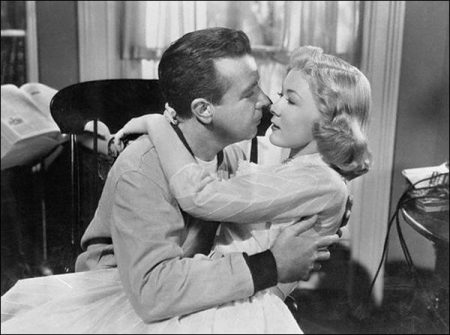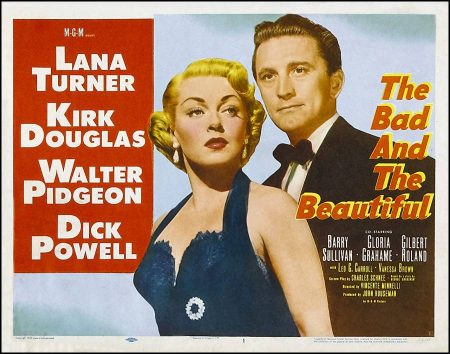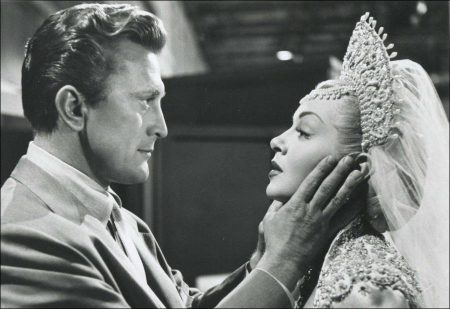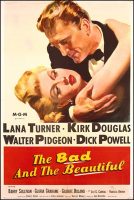Taglines: The story of a blonde who wanted to go places, and a brute who got her there – the hard way!
The Bad and the Beautiful movie storyline. In Hollywood, film director Fred Amiel, movie star Georgia Lorrison, and screenwriter James Lee Bartlow, at the top of their respective professions, each receives a telephone call from Paris from movie producer Jonathan Shields, who they either refuse to speak to or for who they only have nasty, curt words if they do in their estrangement from him.
Jonathan, the son of a now deceased but generally disliked head of his own studio, worked his way up the movie business to prominence despite his father, only to fall out of favor eventually to where his name now means nothing in the business. Although he understands each of their justified feelings toward Jonathan, Harry Pebbel, an associate of Jonathan’s and still his friend, convenes Fred, Georgia and James together in his office to plead Jonathan’s case: he has a new film idea which he cannot get financed on his own, but for which he can get easy financing with Fred, Georgia and James’ direct involvement.
As Harry gets Jonathan on the phone for him to plead his case directly if the three will listen, Fred, Georgia and James recollect their respective relationships with Jonathan: not only the reason they cut ties with him, but also their professional and in most cases personal friendships with him before those falling outs. The question becomes whether in remembering their entire histories and knowing the reason for Jonathan calling them, Fred, Georgia and/or James will at least listen to Jonathan when Harry gets him on the phone this time around.
The Bad and the Beautiful is a 1952 American melodrama that tells the story of a film producer who alienates all around him. The film was directed by Vincente Minnelli and written by George Bradshaw and Charles Schnee. It stars Lana Turner, Kirk Douglas, Walter Pidgeon, Dick Powell, Barry Sullivan, Gloria Grahame and Gilbert Roland. The Bad and the Beautiful resulted in five Academy Awards out of six nominations in 1952, a record for the most awards for a movie that was not nominated for Best Picture or for Best Director.
In 2002, the United States Library of Congress deemed the film “culturally significant” and selected it for preservation in the National Film Registry. The theme song, “The Bad and the Beautiful”, penned by David Raksin, became a jazz standard and has been cited as an example of an excellent movie theme.
The Bad and the Beautiful was created by the same team that later worked on another film about the film business, Two Weeks in Another Town (1962): director (Vincente Minnelli), producer (John Houseman), screenwriter (Charles Schnee), composer (David Raksin), male star (Kirk Douglas), and studio (MGM).
Both films also feature performances of the song “Don’t Blame Me,” by Leslie Uggams in Two Weeks and by Peggy King in The Bad and the Beautiful. In one scene of Two Weeks in Another Town, the cast watches clips from The Bad and the Beautiful in a screening room, presented as a film that Douglas’s character in Two Weeks, Jack Andrus, had starred in. Two Weeks is not a sequel, however, as the characters in the two stories are unrelated.
The Bad and the Beautiful (1952)
Directed by: Vincente Minnelli
Starring: Lana Turner, Kirk Douglas, Walter Pidgeon, Dick Powell, Barry Sullivan, Gloria Grahame, Gilbert Roland, Elaine Stewart, Vanessa Brown, Ivan Triesault, Madge Blake, Hadda Brooks
Screenplay by: Charles Schnee
Cinematography by: Robert L. Surtees
Film Editing by: Conrad A. Nervig
Set Decoration by: F. Keogh Gleason, Edwin B. Willis
Art Direction by: Edward C. Carfagno, Cedric Gibbons
Music by: David Raksin
MPAA Rating: None.
Distributed by: Metro-Goldwyn-Mayer, Loew’s Inc.
Release Date: December 25, 1952 (Los Angeles), January 15, 1953 (New York City)
Views: 229



